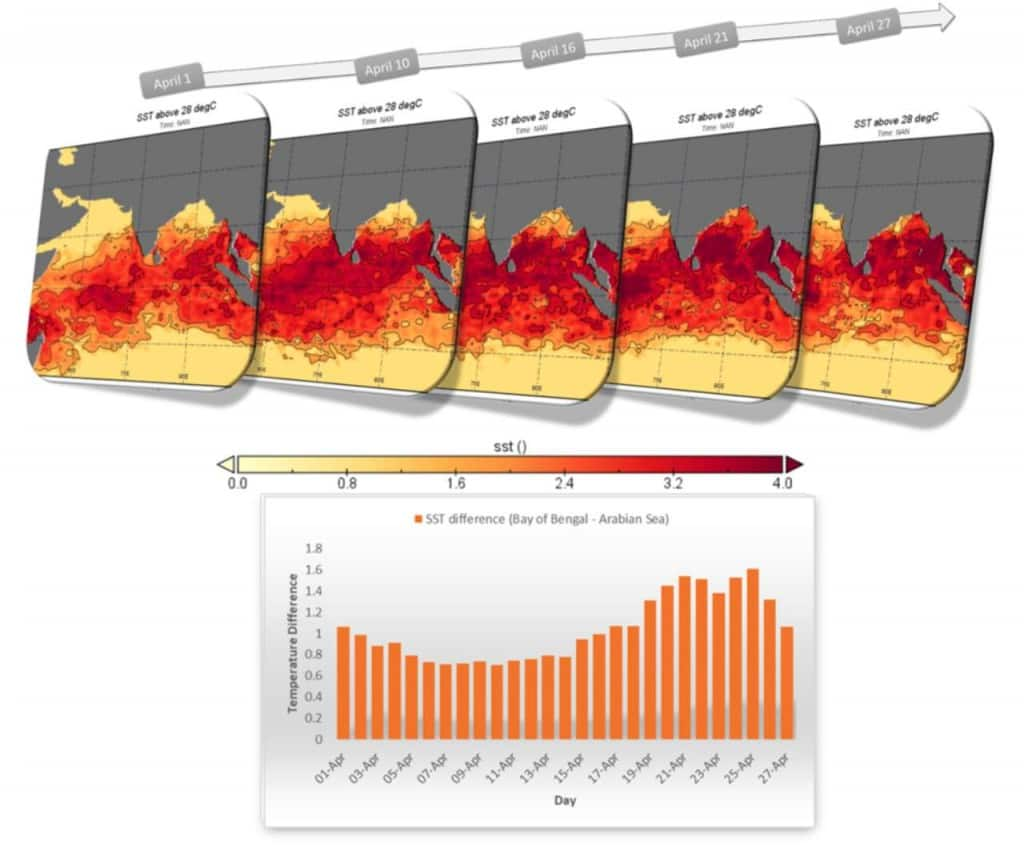Cyclone Fani has begun developing rapidly over the past few days, with its impact after landfall underway and forecasted to grow more intense. Landfall is expected between 8 and 11 am on 3 May, the India Meteorological Department has said. The IMD’s Cyclone Warning Division said that wind speeds could reach 200-230 kilometres whenever it does make landfall. On analysing some of the typical factors that feed a tropic storm, it is evident that there were many climatic phenomena that contributed to Fani picking up in threat and intensity.
Sea surface temperatures
One of the most important ingredients for a cyclone is warm sea surface temperature. Warm temperatures ensure that convection (heat transfer from warmer to cooler regions) in the atmosphere takes place. From the images below, The temperatures in the Bay of Bengal got progressively warmer from 1 April, especially compared to the temperatures over the Arabian Sea. Northward migration of the sun during spring and summer months along with fairly light winds favour sea surface warming over the Bat of Bengal. [caption id=“attachment_6562731” align=“aligncenter” width=“1024”]  Cyclone Fani progression over the course of April and May 2019. Image: Raghu Murtugudde/Amey Pathak[/caption]
Winds & convection helped intensify Cyclone Fani
Cyclones, depressions or low-pressure areas are regions where the atmospheric pressure in a certain topography is lower than that of the surrounding area. These low-pressure systems form when there is a lot of wind divergence in the upper levels of the troposphere – the lowest layer of the atmosphere, and the one in where nearly all weather conditions take place. The troposphere houses ~75 percent of the atmosphere’s mass and 99 percent of water vapor and aerosols by mass. All low-pressure systems like cyclones begin with a convection cell – a system with differences in the densities of water in areas that have different temperatures. The convection cell system helps the warm water propagate in the form of waves from an existing process of convection. Fani started off as a low-pressure system over the equatorial Indian Ocean around 24 April and propagated northward and northwestward, hence changing from one convection system to another.
via GIPHY Sea level pressure differences in the Arabian Sea and Bay of Bengal. Image: Raghu Murtugudde/Amey Pathak In the graphic above, we see a blue blob (a low-pressure region surrounded by high-pressure areas) heading from the equator to the Bay of Bengal and towards Andhra Pradesh. This is a snapshot of Fani growing from a depression to a full-blown tropical severe storm by 29 April. Once the depression deepens into a storm, it is powerful enough to demand moisture from the surrounding region. The moisture transport into the hungry storm is supplied by winds which begin to be pulled towards and around the low-pressure center of the storm. [caption id=“attachment_6562861” align=“aligncenter” width=“1024”] Cyclone Fani developing into a severe cyclonic storm. Image: Raghu Murtugudde/Amey Pathak[/caption] Starting 16 April, the unorganised winds had begun rotating around the depression that was created, and by 23-26 April the storm intensified considerably into a well-formed tropical storm by 29 April. Winds are seen converging into the severe storm from far distances and rotating around the storm in a counterclockwise direction. This indicates that the storm was continuing to strengthen.
There was no “beheading” Fani
A cyclone like Fani is strong enough to pull winds above the sea surface several kilometers upwards into the atmosphere. Lower atmospheric winds are seen here being dragged into and around Fani from regions as far as away as the Middle East. The surface winds tend to be slower due to surface friction but winds in the free atmosphere are stronger. Evolution of the winds near the surface shows the evolution of large scale winds in response to the pull by the deepening storm. Image: Raghu Murtugudde/Amey Pathak via GIPHY. Another critical requirement for a low-pressure area to grow into a cyclone is vertical shear – the change in wind intensity with height in the atmosphere. These forces interact dynamically with thunderstorms to either enhance or diminish the strengths of drafts that go up in storms. It needs to be very weak, like in the case of Fani, for storms to pick up in intensity. When these forces are stronger, vertical shear can chop the head off a cyclone and decimate it. Red and yellow colors in the graphic below show how the vertical shear was unfavorably from the equator to the Bay of Bengal, allowing Fani to grow into a severe and very severe storm by 29 April.
via GIPHY Vertical shear in the atmosphere (Red being strong and blue being weak) allowed cyclone Fani to develop into a severe storm unhindered. Image: Raghu Murtugudde/Amey Pathak Now, as the cyclone makes landfall in Odisha, millions near the eastern coast of India and Bangladesh are in danger as tropical cyclone Fani moves along the coastline. You can follow live updates on **Cyclone Fani as it makes landfall and progresses over the days to come** .


)

)
)
)
)
)
)
)
)



